you are here [x]: Scarlet Star Studios > the Scarlet Letters > compositing, retro-style
<< before
poem: lot's wife at the new year
after >>
animating: sand, paint, shadow
January 14, 2006
compositing, retro-style
by sven at 11:59 pm
I finally finished the Super8 final project Thursday night; it took 19 hours to complete actual shooting. I squeezed in a lot of interesting experiments, so I'm going to break this story up into more than one post.
The trick I'm most proud of was making a ghostly skull appear in place of my face -- without any use of digital compositing!
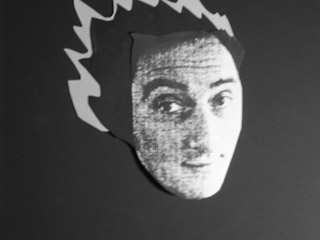
Note: Super8 is, of course, actual celluloid. What you see here are photos that I took with a digital camera from the same angle as the Super8 cam, so I could document my process.
The "ghost" trick begins with this image of my face. The image is just a photocopy, blown up from a photograph that I had lying around. The photocopier lopped off the edges of my head -- so I cut out some paper to make that fiery "manga" hairstyle.
As you watch, the face is slowly replaced...
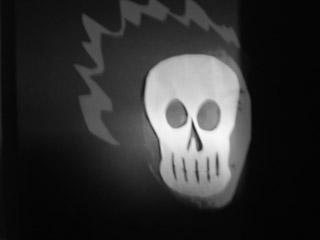
...by this skull, which is a paper cut-out.
How did I achieve the effect? Well, it's a little tricky to explain.
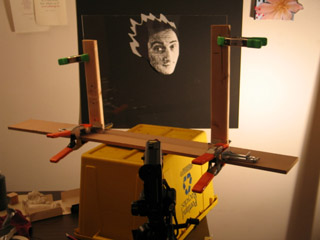
The key to the effect is putting a plate of clear acrylic "glass" between the camera and the image of the face. The glass is at a 45 degree angle, so it will reflect whatever is on the wall to the camera's left.
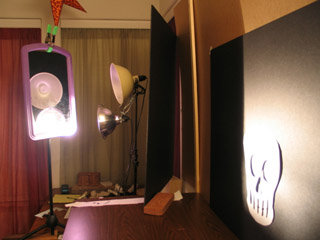
On the wall to the left of the camera, I taped the skull onto a piece of black foamcore. If there's no light on the skull, then there's no reflection on the glass that the camera is looking through. But, throw some light on that skull, and then a reflection appears. If I subsequently turn down the light on the image of the face, then I can almost get it to disappear, so we're left seeing only the skull.
My problem here was in trying to isolate the lighting... If there's any light at all on the skull, then we're going to see some reflection of it in on the glass. The ideal solution would have been to have a spotlight focussed on the skull that was controlled by a dimmer switch. That way I could keep the skull in darkness, and then gradually illuminate it. ...But I didn't have a dimmer switch.
So, what I did instead was have a light pointing away from the skull, but aimed at a mirror. For my purposes, I clamped the mirror to a microphone stand. When the time comes to illuminate the skull, I swivel the mirror on the microphone stand, and the light is bounced onto the skull. Overly complicated -- but pretty effective.
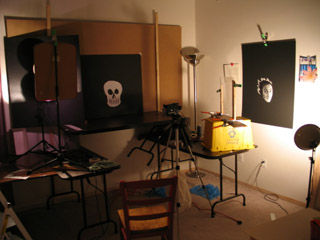
Here's a picture of the whole setup. As you can (hopefully) see, I've got two light sources: one on the left pointed at a mirror, which will illuminate the skull -- and one on the right that's pointed directly at the photo of my face. When it comes time to film the trick, what I do is animate the lights turning. ...For each frame of film, I incrementally turn the one light away from the face -- and the other light so that it's illuminating the skull. Run the film at 18 fps, and the metamorphosis appears!
My understanding is that this is an old theatrical trick... I think it was used around the end of the 1800s to make "ghosts" appear on stage, next to live actors. The trick there, too, was putting a big inclined sheet of glass between the audience and the stage.
More recently, I've seen the trick put to use in science museums, using a two way mirror. At the traveling "Star Trek: Federation Science" exhibit, for instance, I recall there being a station where you could sit in front of this pane of glass, and as you raised the lights on the other side, you could see a Klingon face superimposed over your own. Neat gimick.
Since compositing is so easily done in digital, I don't know when I'll ever need the "ghost" trick again. It's labor intensive, and relies on a complete control of lighting sources, which is difficult to achieve...
Note to self, in case I ever do attempt it again, though: An even more effective means to isolate the light on the skull would be to put a board between the light and the skull, with a "keyhole" in it... Cut out a skull shape in the board, so all extraneous light is truly masked and only a thin beam can shine through.
posted by sven | January 14, 2006 11:59 PM | categories: movies, stopmo